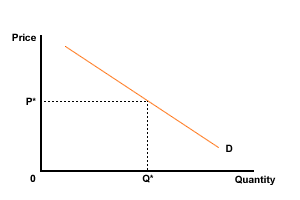Example - shifts and movements along a demand curve
Syllabus: Distinguish between movements along the demand curve and shifts of the demandcurve.
• Draw diagrams to show the difference between movements along the demand curve and shifts of the demand curve.
You must be absolutely certain about what causes shifts and movements along a demand curve. Work carefully through the following example.
| Just
to be very clear - while the following focuses on what determines the
position of the demand curve on the graph in IB answers never use a demand curve on its own
a graph showing the demand curve shifting position without the supply
curve is meaningless you need both to say what happens to price and
quantity and therefore make conclusions. |
Letīs do Some Economics
Example 1 - Movements along and shifts of a demand curve
The diagram below, Figure 1, represents the demand for a product at a point in time. The price then was P*.

Figure 1 Demand curve
Copy this onto another piece of paper, then sketch on this new diagram the effect of the following changes. Treat each change as a separate change - in other words start each time from Figure 1. Once you have had a go at each one then follow the link below to check you got the change right.
(a) The firm launches a new, effective advertising campaign (change in tastes and fashion - T)
Answer - change (a)
(b) The market price of the product rises to P2. (change in the goodīs own price - Po)
Answer - change (b)
(c) The price of a substitute good is reduced. (change in the price of other goods - Pz)
Answer - part (c)
(d) The price of a good falls from P1 to P2. (Po)
Answer - part (d)
(e) The real incomes of the buyers of this desirable product increase significantly. (Y)
Answer - part (e)
(f) There is an increase in the population size and the size of the potential market. (P)
Answer - part (f)
These should not be difficult if you keep calm. Ask yourself three questions:
- Has a 'ceteris paribus' factor (or a non-price determinant of
demand other than the price of the good itself) changed? If the answer
is yes, then there is a shift of the whole curve.
- Will demand increase or decrease? This will determine if the shift
is to the right or left - It can cause some people confusion if the
demand curve is seen as shifting its position upwards or downwards - if
the demand curve shifts downwards then demand has gone up (increased).
Say what???? Yes check it out on a diagram. Therefore you need to think
shift right (increase) and shift left (decrease) - with one exception
and that is to do with supply and tax (more later).
- If the price has changed, will there be an extension (increase) or contraction (decrease) of demand?
